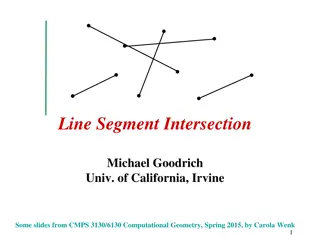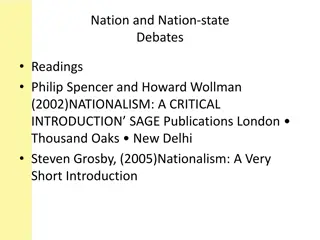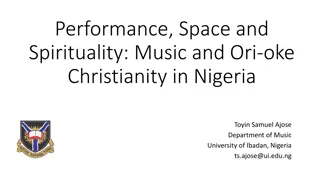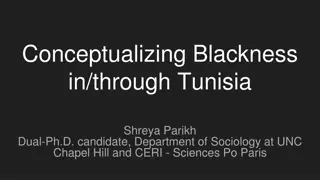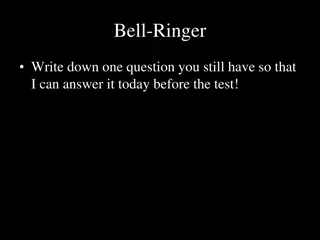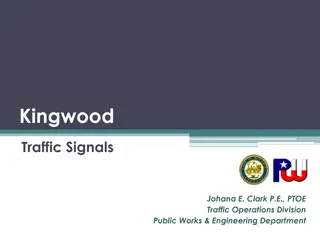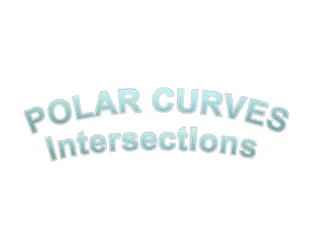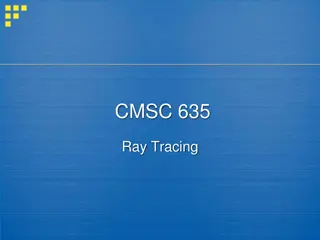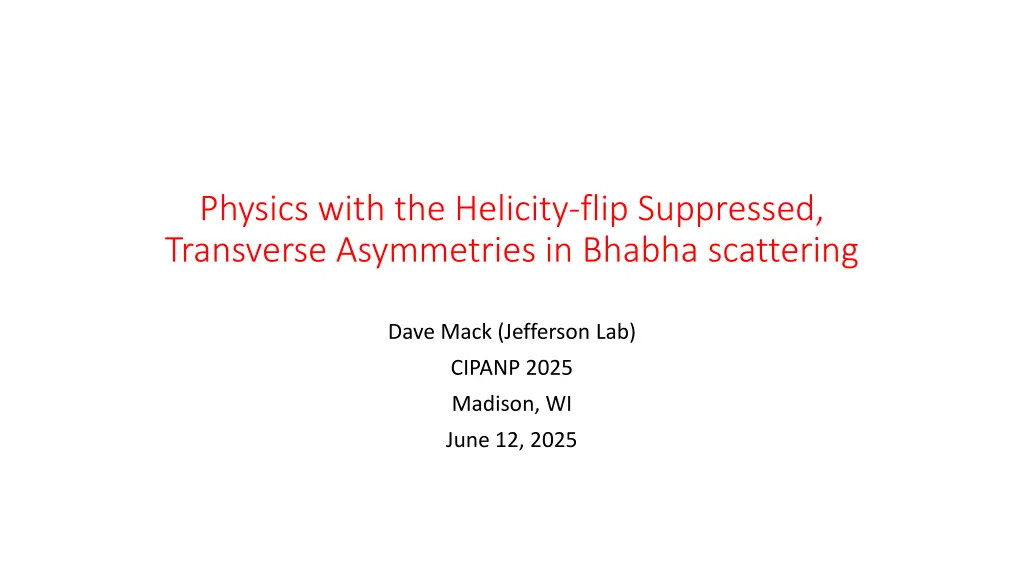
Exploring Transverse Asymmetries in Bhabha Scattering
Uncover the unexplored realm of transverse asymmetries in Bhabha scattering through a detailed study at Jefferson Lab, focusing on the development of a polarized positron injector and the potential for groundbreaking polarized e+e- measurements. Dive into the world of purely leptonic reactions at JLab and understand the interplay between s- and t-channel amplitudes in Bhabha scattering, shedding light on both standard and beyond standard model possibilities.
Download Presentation

Please find below an Image/Link to download the presentation.
The content on the website is provided AS IS for your information and personal use only. It may not be sold, licensed, or shared on other websites without obtaining consent from the author. If you encounter any issues during the download, it is possible that the publisher has removed the file from their server.
You are allowed to download the files provided on this website for personal or commercial use, subject to the condition that they are used lawfully. All files are the property of their respective owners.
The content on the website is provided AS IS for your information and personal use only. It may not be sold, licensed, or shared on other websites without obtaining consent from the author.
E N D
Presentation Transcript
Physics with the Helicity-flip Suppressed, Transverse Asymmetries in Bhabha scattering Dave Mack (Jefferson Lab) CIPANP 2025 Madison, WI June 12, 2025
Overview Overview Jefferson Lab, a 12 GeV polarized electron, fixed target facility, is developing a polarized positron injector. For more information on the polarized e+ source, see the link at Positron beams at Ce+BAF A positron beam facility at Jlab would enable a detailed study of Bhabha scattering (e+ e- e+ e- ) in the relatively unexplored CM mass range of 10 to 100 MeV/c2 . Targets consisting of atomic electrons will permit practical e+e- luminosities of 1035 to 1036. (The cross sections are also surprisingly large due to the small value of s.) The resulting high count rates, combined with Jlab s superb expertise in spin manipulation, would enable Bhabha transverse polarization measurements of unprecedented precision. Although Bhabha scattering is arguably one of the most well studied reactions in particle physics, the transverse asymmetries are largely unexplored, and interesting questions can still be addressed. 3
Purely Purely Leptonic Leptonic Reactions Accessible at Reactions Accessible at JLab JLab Currently, only one purely leptonic reaction is accessible at Jlab: Moeller scattering (e- e- e- e-). With the planned e+ injector, two more will become available: Bhabha scattering (e+ e- e+ e-), and Sub-threshold di-muon production (e+ e- + -)* I will focus on polarized Bhabha scattering (e+ e- e+ e-) in this talk for reasons that will become clear. *i.e., only possible by scattering on relativistic electrons in the inner shells of high Z nuclei. 4
Bhabha Bhabha Scattering: e Scattering: e+ + e e- - e e+ + e e- - s-channel The s-channel amplitudes are constrained by the spin of the exchanged particle: In the Standard Model (SM), the exchanged boson is effectively a or Z0 (ie, spin = 1). Beyond the SM (BSM), other particles can be exchanged (eg, spin = 0). t-channel Of the 3 purely leptonic reactions I mentioned on the last slide, only Bhabha scattering features the interference between s- and t-channel amplitudes. 5
Bhabha Bhabha d d /d /d vs vs CM CM The differential xsect has 2 regions: The forward, t-channel dominated regime would in principle provide very large xsects. The backward regime accesses s-channel annihilation, as well as interference of s- and t-channel exchange. t-channel dominated scattering For 6 GeV positron beam energy, the backward xsects are still quite large by Jlab standards (a few B/sr). s-channel dominated annihilation s-t Dominated interference 6
Helicity Amplitudes Notation Helicity Amplitudes Notation Fijkl represents the amplitude for transition between initial state ij and final state kl (ie, Fe+e-e+e- =Finitialfinal ) The indices are L or R , so there are at most 2x2x2x2 = 16 helicity amplitudes. You may often see it written as Fij ( ie Finitial) since the final e+e- polarizations are generally not measured. This implies a summation over the 4 final helicity states (LR, RL, LL, and RR). I will write it as Fijkl,s to denote the s-channel contribution, or Fijkl,t to denote the t-channel contribution. 7
The t The t- -channel Helicity Amplitudes channel Helicity Amplitudes In the t-channel, helicity is largely conserved at each vertex, with flip probabilities suppressed by one or two factors of 1/ = 2me/Ecm . Unsuppressed scatterings are LR LR, RL RL, LL LL, and RR RR. High energy collider papers typically treat the matrix as if it were purely diagonal (the so-called me 0 limit). Final e+e- helicity LR RL LL RR FLRLR,t LR 0 0 0 Initial e+e- helicity FRLRL,t RL 0 0 0 FLLLL,t LL 0 0 0 FRRRR,t RR 0 0 0 8
The t The t- -channel Helicity Amplitudes channel Helicity Amplitudes In the t-channel, helicity is largely conserved at each vertex, with flip probabilities suppressed by one or two factors of 1/ = 2me/Ecm . Unsuppressed scatterings are LR LR, RL RL, LL LL, and RR RR. For fixed target e+ experiments at Jlab with ppm-level statistical errors, the SM off-diagonal terms will be important even at a beam energy of 10 GeV (ie, ~ 100). High energy collider papers typically treat the matrix as if it were purely diagonal (the so-called me 0 limit). Final e+e- helicity Final e+e- helicity LR RL LL RR LR RL LL RR FLRLR,t ~1/ 2 LR ~1/ ~1/ FLRLR,t LR 0 0 0 Initial e+e- helicity Initial e+e- helicity ~1/ 2 FRLRL,t RL ~1/ ~1/ FRLRL,t RL 0 0 0 FLLLL,t ~1/ 2 LL ~1/ ~1/ FLLLL,t LL 0 0 0 ~1/ 2 FRRRR,t RR ~1/ ~1/ FRRRR,t RR 0 0 0 9
s s- -channel Constraints on Exchanged J channel Constraints on Exchanged J e- e+ s-channel annihilation filters the spin of the exchanged boson: LR Jz = -+1 (SM vectors) RL Adapted from G. Moortgat-Pick et al., Phys. Rept. 460:131-243, 2008 10
s s- -channel Constraints on Exchanged J channel Constraints on Exchanged J e- e+ s-channel annihilation filters the spin of the exchanged boson: LR Jz = -+1 (SM vectors) RL LL Jz = 0 (SM Higgs, BSM scalars) RR The SM Higgs coupling to the small electron mass is 3E-6, so the amplitude of the above diagram would be 1E-11 hence unmeasureably small. Adapted from G. Moortgat-Pick et al., Phys. Rept. 460:131-243, 2008 11
The SM s The SM s- -channel Helicity Amplitudes channel Helicity Amplitudes In the s-channel, only scatterings consistent with the exchange of a spin = 1 gamma or Z are allowed in first order, with exceptions suppressed by factors of 1/ = 2me/Ecm . The unsuppressed scatterings are the 4 combinations of LR or RL. In the me 0 limit, the SM s-channel amplitudes are zero for LL or RR. Final e+e- helicity LR RL LL RR FLRLR,s FLRRL,s LR 0 0 Initial e+e- helicity FRLLR,s FRLRL,s RL 0 0 LL 0 0 0 0 RR 0 0 0 0 12
The SM s The SM s- -channel Helicity Amplitudes channel Helicity Amplitudes In the s-channel, only scatterings consistent with the exchange of a spin = 1 gamma or Z are allowed in first order, with exceptions suppressed by factors of 1/ = 2me/Ecm . The unsuppressed scatterings are the 4 combinations of LR or RL. In the me 0 limit, the SM s-channel amplitudes are zero for LL or RR. For fixed target e+ experiments at Jlab, we will of course use the exact 1st order QED helicity amplitudes. Final e+e- helicity Final e+e- helicity LR RL LL RR LR RL LL RR FLRLR,s FLRRL,s FLRLR,s FLRRL,s LR 0 0 LR ~1/ ~1/ Initial e+e- helicity Initial e+e- helicity FRLLR,s FRLRL,s FRLLR,s FRLRL,s RL 0 0 RL ~1/ ~1/ ~1/ 2 ~1/ 2 LL 0 0 0 0 LL ~1/ ~1/ ~1/ 2 ~1/ 2 RR 0 0 0 0 RR ~1/ ~1/ 13
Unsuppressed s Unsuppressed s- -channel Helicity Amplitudes with a BSM Scalar channel Helicity Amplitudes with a BSM Scalar BSM scalars Final e+e- helicity LR RL LL RR ~1/ 2 ~1/ 2 LR ~1/ ~1/ Initial e+e- helicity ~1/ 2 ~1/ 2 RL ~1/ ~1/ FLLLL,s FRRRR,s LL ~1/ ~1/ FRRLL,s FRRRR,s RR ~1/ ~1/ Polarization observables containing the helicity amplitudes FLLLL, FLLRR, FRRRR, or FRRLL seem potentially interesting for BSM scalar searches, because the SM vector exchange backgrounds are suppressed by 1/ 2. Let s hunt for an appropriate observable. 14
Helicity Amplitudes in Helicity Amplitudes in Bhabha Bhabha Scattering Scattering 4|M|2 = +|FLR|2 + |FRL|2 + |FLL|2 + |FRR|2 Unpolarized xsect An unpolarized energy scan of the xsect at backward angles could search for scalars. But barring a resonance between Ecm = 10-100 MeV/c2, the sensitivity would be low since the SM vector backgrounds in the s-channel would be large, i.e, |FLR|2 + |FRL|2 >> |FLL|2 + |FRR|2 These slides are adapted from: Polarized positrons and electrons at the linear collider , G. Moortgat-Pick et al., Phys. Rept. 460:131-243,2008, https://arxiv.org/abs/hep-ph/0507011 15
Helicity Amplitudes in Helicity Amplitudes in Bhabha Bhabha Scattering Scattering 4|M|2 = +|FLR|2 + |FRL|2 + |FLL|2 + |FRR|2 Unpolarized xsect + Pe-L( +|FRL|2 + |FRR|2 |FLR|2 |FLL|2 ) Longitudinal polarization only + Pe+L( -|FRL|2 + |FRR|2 + |FLR|2 |FLL|2 ) + Pe-L Pe+L ( - |FRL|2 + |FRR|2 - |FLR|2 + |FLL|2 ) Adding L polarization alone would not greatly expand the Bhabha physics program: The longitudinal single spin asymmetries ALU or AUL are parity violating, and at tree level are only O(10) ppb. Low energy constraints on BSM sources of parity violation are already excellent thanks to Atomic PV on Cesium, E158, and Q-weak. The Hall A Moeller experiment will improve on the purely leptonic constraints. And frankly, a competitive PV measurement with few % precision and only 50 nA of polarized e+ beam would require 1000 s of years. The double spin asymmetry ALL is large, essentially a SM candle that could be used for polarimetry. 16
Helicity Amplitudes in Helicity Amplitudes in Bhabha Bhabha Scattering Scattering 4|M|2 = +|FLR|2 + |FRL|2 + |FLL|2 + |FRR|2 Unpolarized xsect + Pe-L ( +|FRL|2 + |FRR|2 |FLR|2 |FLL|2 ) Longitudinal polarization only + Pe+L ( -|FRL|2 + |FRR|2 + |FLR|2 |FLL|2 ) + Pe-L Pe+L ( - |FRL|2 + |FRR|2 - |FLR|2 + |FLL|2 ) + Pe-T ( +2Re(FRLFLL* + FRRFLR*) cos( m ) Transverse polarization introduces the interference of helicity amplitudes, and would be insanely enriching. -2Im(FRL*FLL - FRR*FLR) sin( m - ) ) + Pe+T ( -2Re(FLRFLL* + FRRFRL*) cos( p ) -2Im(FLR*FLL - FRR*FRL) sin( p - ) Require Transverse polarization (including L-Tasymmetries) + Pe-TPe+T ( -2Re(FRRFLL*)cos( m p) None of the asymmetries implied here have apparently ever been deliberately measured. -2Im(FRR*FLL)sin( m p) - 2Re(FLRFRL*)cos( m+ p-2 ) +2Im(FLR*FRL)sin( m+ p-2 ) ) + Pe+LPe-T ( -2Re(+FRLFLL* - FRRFLR*)cos( m ) +2Im(FRL*FLL + FRR*FLR)sin( m ) ) + Pe+TPe-L ( +2Re(FLRFLL* - FRRFRL*)cos( p ) +2Im(FLR*FLL + FRR*FRL)sin( p ) ) 17
Summary Table of the Transverse Asymmetries Summary Table of the Transverse Asymmetries Don t despair, I hate formula-filled slides too! To make transverse asymmetries less overwhelming, let me reduce those 12 asymmetries to only 4, by dropping the PV ones, and any redundant ones (assuming no CP violation), and giving them easy and obvious names: Transverse Asymmetry Proportional to These Helicity Amplitudes Dependence Suppression in SM Comment ATT - 2Re(FLRFRL*) cos( m+ p-2 ) Unsuppressed. SM candle for polarimetry. Sensitive to scalar exchange which produces unsuppressed double helicity flip. My article is in (slow!) preparation. ATT -2Re(FRRFLL*) cos( m p) 1/ 2 / For annihilation channels, Wen et al find these useful to search for BSM sources of unsuppressed single helicity flip.* I find ALT in Bhabha to be insensitive to BSM scalar exchange. ATU -2Im(FLR*FLL - FRR*FRL) sin( p - ) (two-photon) ALT -2Re(+FRLFLL* - FRRFLR*) cos( m ) 1/ * X-K Wen et al, PRL 131, 241801 (2023). 18
The Double Spin Asymmetry, ATT (a highly unusual transverse asymmetry, sensitive to BSM scalar exchange) 19
T Polarized e T Polarized e+ + Beam, T Polarized e Beam, T Polarized e- -Target Target YieldTT( , ) ~-Re(FRRFLL*)cos( m p) - Im(FRR*FLL)sin( m p) - Re(FLRFRL*)cos( m+ p-2 ) + Im(FLR*FRL)sin( m+ p-2 ) PC PV p is the azimuthal polarization angle of the e+ beam. m is the azimuthal polarization angle of the e- in the target. For this observable, the cosine terms are PC and therefore dominant. We will ignore the PV terms. 20
T Polarized e T Polarized e+ + Beam, T Polarized e Beam, T Polarized e- -Target Target YieldTT( , ) ~-Re(FRRFLL*)cos( m p) - Re(FLRFRL*)cos( m+ p-2 ) Again, the two asymmetries implied above are: ATT : The term Re(FLRFRL*) cos( m+ p-2 ) has no helicity suppression, hence the asymmetry is relatively large. We will use this observable for polarimetry to tell us the product of polarizations Pe-TPe+T. ATT : The term Re(FRRFLL*) cos( m p) is doubly helicity suppressed, and will be the focus of the rest of this section. 21
A ATT TT and andA ATT TT YieldTT( , ) ~ATT cos( m p) + ATT cos( m+ p-2 ) 22
A ATT TT and andA ATT TT YieldTT( , ) ~ATT cos( m p) + ATT cos( m+ p-2 ) To simplify this a bit, use rotational invariance to always define the e- transverse polarization axis as 0: YieldTT( , ) ~ATT cos( p) + ATTcos( p-2 ) The relatively large ATT signal oscillates like cos(2 ). 23
A ATT TT and andA ATT TT YieldTT( , ) ~ATT cos( p) + ATTcos( p-2 ) The much, much smaller ATT signal is a monopole, ie, independent of the e+ . 24
A ATT TT and andA ATT TT YieldTT( , ) ~ATT cos( p) + ATTcos( p-2 ) ATT is unique: it is the only transverse polarization observable which, for fixed m p, survives integration over and thus contributes a tiny amount to the total cross section. This signal reverses when m or p is reversed. (below) cos( m p) = 0 cos( m p) = -1 cos( m p) = +1 25
Explicit Explicit Bhabha Bhabha QED Helicity Amplitudes QED Helicity Amplitudes I could not find any published calculations of ATT . But Hikasa and others have published the following 1st order helicity amplitudes for non-vanishing electron mass.* Hikasa Term Helicity Amplitudes Approximate Analytic Expression (setting = 1 for readability) FRLRL = FLRLR = e2 [ 2/(1-cos )) - 1 ](1+cos ) 1 FRLLR = FLRRL = e2 [ 1/ 2 - (1-cos ) ] 2 FLLRL = FRRRL = -FLLLR = -FRRLR = -FRLLL = -FRLRR = FLRLL = FLRRR FRRRR = FLLLL = 3 e2 (1/ )[ 1/(1-cos ) - 1 ]sin e2 [ 4/(1-cos ) (1+cos )/ 2 ] 4 FRRLL = FLLRR = e2 (1/ 2)[ (1+cos ) ] 5 If BSM scalars exist, the major effect would be a helicity unsuppressed s-channel contribution to Terms 4 and 5. * K. Hikasa, PRD 33 (1986) 3203 (see Appendix D) 26
A ATT TT Calculation in the SM Calculation in the SM To calculate ATT , I need to expand the initial-indices-only shorthand of FRRFLL : FRRFLL =FRRLRFLLLR + FRRRLFLLRL + FRRLLFLLLL+FRRRRFLLRR Because Term 3 is suppressed much more than the factor of 1/ naively suggests, the dominant SM contribution is from the latter two Term4*Term5 products, FRRLLFLLLL +FRRRRFLLRR . FLLLL and FRRRR are ~ e2 4/(1 cos ) : unsuppressed t-channel exchange FLLRR and FRRLL are ~ -e2 (1 + cos )/ 2 : suppressed s-channel exchange + potential BSM physics J = 1 + s-channel t-channel (unsuppressed) (suppressed by 1/ 2 for FLLRR and FRRLL ) 27
Magnitudes of Terms 4 and 5 at Backward Angles Magnitudes of Terms 4 and 5 at Backward Angles ATT is proportional to the product Term4*Term5. Term 5 is highly helicity suppressed if J = 1 particles like photons are exchanged. Term 5 is not helicity suppressed when J = 0 particles are exchanged. s-channel SM-suppressed amplitude O(1E-4) t-channel carrier wave O(1) 28
A ATT TT Result in the SM Result in the SM Here is the asymmetry using the exact 1st order QED helicity amplitudes: The asymmetry is fairly small, ~75 ppm at 6 GeV at 90deg. There is no zero crossing. (For what it s worth, I note that 1/ 2 is 167 ppm.) The sign convention for this asymmetry was [ Yield(+1,+1) Yield(-1,+1) ]/Sum 29
Adding a BSM Scalar to A Adding a BSM Scalar to ATT TT I added the BSM scalar amplitude in a manner suggested in the old Hikasa reference. However, to eventually publish a plot of projected exclusion in scalar coupling vs mass, and compare to modern papers, I need to incorporate the propagator. This is a work in progress. The dominant scalar contribution to ATT will be thru doubly suppressed amplitudes FLLRR and FRR LL FRRLL = FLL RR = - e2(1 + cos )/ 2 + gs2*propagator then ATT ~ FRRLLFLLLL +FRRRRFLLRR would be approximately 2[4e2/(1 cos )] *[ -e2 (1 + cos )/ 2 + gs2*propagator ] * K. Hikasa, PRD 33 (1986) 3203 (page 3208) 30
A ATT TT Including a BSM Scalar Amplitude Including a BSM Scalar Amplitude Very preliminary. For E = 6 GeV, which corresponds to Ecm ~ 77.5 MeV/c2. The scalar mass was set to 25 MeV/c2, and a coupling gs = 1E-3. Comments: the Mass << Ecm scenario. This plot is representative of The other two scenarios are: (contact interaction, less sensitive) Mass >> Ecm and Mass ~ Ecm (resonance, much more sensitive). 31
Transverse Asymmetry Magnitudes vs Transverse Asymmetry Magnitudes vs E Ebeam beam This plot gives an idea of the magnitude variation expected for these helicity- suppressed asymmetries. ATT ~ 0.11 ALT ~ 1/ ATT ~ 1/ 2 ATU ~ / 32
Transverse Asymmetry Magnitudes vs Transverse Asymmetry Magnitudes vs E Ebeam beam Below 100 MeV, ATT and ALT become larger than 1%. We will likely make the first measurements of these asymmetries in the future e+ injector, years before GeV- scale positrons are available in Hall C. This plot gives an idea of the magnitude variation expected for these helicity- suppressed asymmetries. ATT ~ 0.11 >1% ALT ~ 1/ ATT ~ 1/ 2 ATU ~ / 33
Transverse Asymmetry Magnitudes vs Transverse Asymmetry Magnitudes vs E Ebeam beam Below 100 MeV, ATT and ALT become larger than 1%. We will likely make the first measurements of these asymmetries in the future e+ injector, years before GeV- scale positrons are available in Hall C. This plot gives an idea of the magnitude variation expected for these helicity- suppressed asymmetries. ATT ~ 0.11 >1% ALT ~ 1/ ATT ~ 1/ 2 International Workshop on Low Energy e Physics at Jefferson Lab (LEEPP@JLab) Nov 3-7, 2025 ATU ~ / 34
Summary Summary ATT : I find this asymmetry to be sensitive to light J = 0 particle exchange (which is a BSM source of unsuppressed, double helicity flip). ALT : I find this double-spin asymmetry is not sensitive to light J = 0 particle exchange. By analog to the work of Wen et al, it may be sensitive to BSM sources of unsuppressed, single helicity flip, referred to in their work as SMEFT dipole operators. 35
extras 36
Can We Actually Pull Out the ATTSignal? Target e- polarization fixed at 0deg. Reversing the e+ polarization reverses all asymmetries. ATT represented by big signal. I injected an instrumental asymmetry as a multiplicative factor ATT represented by small, monopole signal. 37
Can We Actually Pull Out the ATTSignal? Calculating the asymmetry after reversing the e+ polarization: Averaging over the azimuthal angle in principle cancels the large cos(2 ) asymmetry, leaving ATT . Extraction of ATT looks feasible provided cancellation of the cos(2 ) asymmetry is excellent. Instrumental asymmetry as a multiplicative factor of course cancels exactly: A = (gN+ - gN-)/(gN+ + gN-) = (N+ - N-)/(N+ + N-) 38
But What About Nonlinearity? Keep in mind, the cos(2 ) term is 4 orders of magnitude larger than the monopole signal of ATT ! A quick study suggests nonlinearity as large as 1% would not be a serious issue if it is the same for all detector channels. But a differential nonlinearity between detectors at the +-1% level would break the azimuthal asymmetry. This is potentially serious since I find the resulting leakage into the monopole reverses just like the physics signal of interest when m or p is reversed: The brute force solution would be to design highly linear detectors, use beam intensity noise to measure the remaining small nonlinearity for each detector bin, then make corrections. 39
But What About Nonlinearity? A more elegant and robust solution would be, for half the experiment, to shift the phase of the cos(2 ) signal by 90 degrees. Thus, while the ATT signal is held constant, background peaks in a detector would become troughs in the same detector, and vice versa. The following would largely cancel the cos(2 ) background, as well as any broken symmetries induced by nonlinearity: ATT ~ [Y(+0 ,+0 ) + Y(+90 ,+90 )] [Y(0 ,+180 ) + Y(+90 , -90 )] Original ATT calculation Revised ATT calculation So we d need to be able to do slow reversals which alternate between Horizontal and Vertical transverse polarization, while adjusting the target polarization angle by 90 as well. This needs much more study. But I think I have identified the most serious issue with ATT , and have a tentative solution. 40
H running (Tgt angle also H) p p 180 90 0 -90 180 0 180 m- p = 0 ( m+ p = 0) 90 (90) 180 (180) -90 (90) 180 m- p = 0 ( m+ p = 0) 180 (180) m 90 -90 (-90) 0 90 (90) 180 (0) (180) 0 -180 (180) 0 m (0) 0 -180 (180) -90 (90) 0 90 (-90) (0) V running (Tgt angle also V) p -90 90 (90) -180 (0) -90 (-90) 0 (-180) 90 -90 90 0 180 (0) ATT with excellent cos(2phi) cancellation = (Yellow+Orange) (Green+Yellow-green) m (180) -90 -180 (0) 0 The unused 90 (90) blocks above would be null tests for ATT . As can be seen on the right, these null settings do not occur in normal H or V running setups. (-180) 41
At any fixed Flip e+, reverse signal Flip e-, reverse signal 42
Ecm in Bhabha Scattering in Jlab Fixed Target Kinematics At a 12 GeV CEBAF, the CM energy range will be ~20-105 MeV/c2. Ecm = sqrt(s) = sqrt(2me2 + 2Ebeam*me) ~ sqrt(Ebeam) Notes: due to the sqrt factor above, it takes a roughly 100 MeV change in Ebeam to produce a 1 MeV change in Ecm. (Hold that thought for later!) since the differential xsect contains a factor of 1/s, and s is small, the xsect is large by Jlab standards, O(1)-O(100) muB/sr at 90deg CM. 43
Capability With a Future Positron Injector Machine Parameter Hall Multiplicity Energy (ABC/D) Beam Repetition Duty Factor Unpolarized Intensity Polarized Intensity Beam Polarization Fast/Slow Helicity Reversal Electrons 4 11/12 GeV 249.5/499 MHz 100% cw 170 A 170 A > 85% 1920 Hz/Yes Positrons 1 or 2 11/12 GeV 249.5/499 MHz 100% cw > 1 A > 50 nA > 60% 1920 Hz/Yes ! See talk by Joe Grames at https://indico.jlab.org/event/819/ from the March 2024 PWG Workshop. There were also many talks on future experiments and related theory calculations. 45
The Double Spin Asymmetry, ALT (perhaps useful for BSM dipole interactions) 46
ALT(, ) ALT( , ) ~ Pe+LPe-T [ -Re(FRLFLL* - FRRFLR*)cos( m ) + Im(FRL*FLL + FRR*FLR)sin( m ) ] ATL( , ) ~ Pe+TPe-L [ +Re(FLRFLL* - FRRFRL*)cos( p ) + Im(FLR*FLL + FRR*FRL)sin( p ) ] PC PV Let s focus for now on the PC observable in which the e+ beam is L polarized, and the e- target is T polarized: ALT :The term -Re(FRLFLL* - FRRFLR*)cos( m ) is singly helicity suppressed, decreasing like 1/ . This will be the focus of the rest of this section. Note that ALT has a remarkable complementarity with ATU: the former s PC part measures the Real(FRLFLL* - FRRFLR*) while the latter measures the Imaginary(FRLFLL* - FRRFLR*). 47
ALT vs cm Using the same Hikasa helicity amplitudes: Despite significant cancellation, the asymmetry is not small by JLab standards, ~800 ppm at 6 GeV. This is ~2 orders of magnitude larger than ATT at the same beam energy. There is also a zero crossing at 90degCM. A scalar interaction would evade the helicity suppression in FRRLL and FLLRR . So what does that sensitivity look like? 48
ALT vs cm Oof! This is much less sensitive than ATT . After inserting a large scalar interaction of 4fs2p2 = 0.02 in the helicity amplitudes FRRLL and FLL RR : Handwavingly, ALT appears to be 3 orders of magnitude less sensitive than ATT . Most of that is because the SM background in ALT is ~2 orders of magnitude larger. The remaining reason: our beloved carrier wave, the 1-photon exchange amplitude, is unfortunately helicity suppressed even when the scalar amplitude is not. It s never been measured! 49



